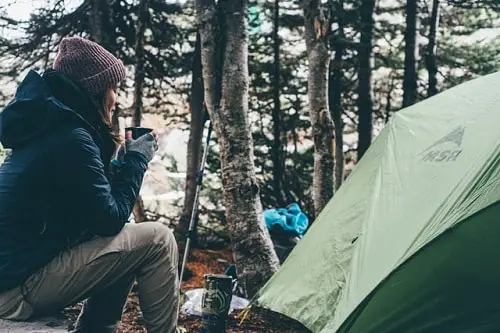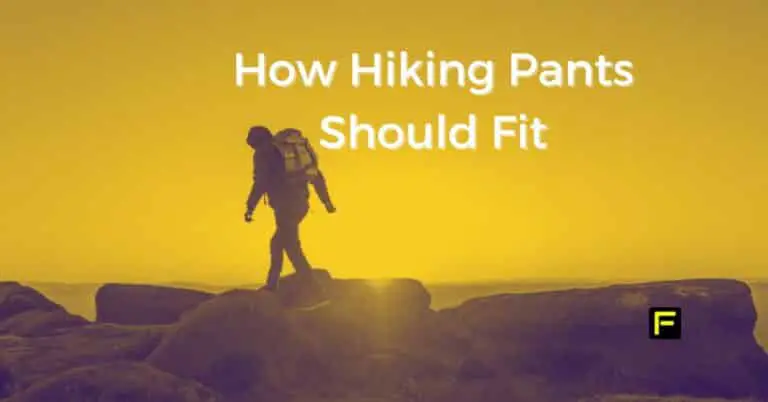When it comes to determining how hiking pants should fit for your next hike, you’ll want them to be comfortable, breathable, and flexible. After all, you don’t want them to restrict your movements or make your hike unpleasant. If they fit properly so that you don’t end up with saggy thigh-highs; even better! But why does pant fit so important for hiking?
** I may earn a commission when you purchase through a link on this page. **
- OMNI-WICK: The ultimate moisture management technology for the outdoors. Omni-Wick quickly moves moisture from the skin into the fabric where it spreads across the surface to quickly evaporate—keeping you cool and your clothing dry.
- OMNI-SHADE: Be safe and protected. Omni-Shade blocks UVA and UVB rays to help prevent sunburns and long-term skin damage. The tight weave construction with UV absorbent yarns block the full spectrum of harmful UV rays.
- ALL WEATHER PANTS: These hard working pants are versatile, durable, and truly protective – engineered to keep you comfortable from sunup to sundown.
How hiking pants should fit
When your hiking pants are too tight, they can cause chafing and irritation. When they are too loose, they will sag everywhere once you start walking instead of staying tucked in at the waistline.
I’m reader-supported. When you buy through links on my site, I may earn an affiliate commission.
It is possible that your hiking pants fit great now, but how will they fit once you begin wearing them on a regular basis?
Read on for more information about how hiking pants should fit so that you can choose the most appropriate ones for your next adventure.

How hiking pants should fit
The 3 main ways how hiking pants should fit
The fit of hiking pants is most likely going to be different for everyone, depending on your body shape, height, and weight. In order to find the right pair of pants that fit you best, you’re going to have to try on several pairs.
For starters, you’re going to have to do some measuring and trial and error. Make sure you take measurements of yourself and the pants you want to try on so that you know what to aim for.
Your waist size is going to be the most important aspect of the fit. Ideally, you want your hiking pants to fit snugly at the waist, but not be so low-cut that it shows your underwear.
The best way to find out your waist size is to wear a belt, but if you don’t have one you can do the following: Take a string and mark where it hits your waist. Then, tie the string to mark your exact waist size.
Read “Best Knee Braces for Hiking“.
How hiking pants should fit
Waist sizing
It is important to remember that hiking pants are typically much wider than your hiking shirt. This means that you will have much more room to choose from in terms of the fit of your hiking pants.
Because of this, you will want to make sure that your hiking pants are snug at the waist. Ideally, you will want to be able to fit two fingers between your skin and the fabric of your hiking pants.
You also want to make sure that your hiking pants fit snugly around the hip and thigh, but also allow you enough room in the leg so that you don’t feel restricted while hiking.
If your hiking pants feel like they are too small in the waist, you may want to try buying a size up. It has been my experience that pants feel better and they’re more comfortable if you err on the side of having additional room than going too tight.
How hiking pants should fit
Leg sizing
When it comes to the fit of your hiking pants, you will want to pay close attention to the fit on the ankle and lower part of the leg.
Ideally, you will want to be able to fit a pair of socks but also have your ankle and lower leg has room to move. Remember, hiking pants are typically much wider than your hiking shirt, so you don’t want them to be too tight.
You will want your hiking pants to feel comfortable when you are standing still, but also when you are hiking.
Be sure that your ankle and lower leg have room to move, but that your hiking pants don’t gap open too much. If you are wearing hiking pants that are too tight in this area, you may want to buy a size up or go with a different brand.
If you are wearing hiking pants that are too loose in this area, you may want to put on a belt and try to fit them a little tighter.
Hip sizing
When it comes to the fit of your hiking pants, you will want to make sure that the hip and thigh area fits you properly, without being too baggy or too small.
Many hikers prefer hiking pants to fit snugly around the hip and thigh, while also having enough room in the leg so that you don’t feel restricted while hiking.
A common mistake that people make when it comes to the fit of hiking pants is that they buy a pair that is too small in the hip/thigh area, while they buy a hiking shirt that is too big.
This means that the pair of hiking pants will fit too low, while the hiking shirt will be oversized. This can make you look sloppy, and feel boxy and clumsy.
Properly fitted hiking pants will allow you to move around freely and not feel restricted. They can also mean the difference in your overall comfort level during your trek or excursion.
How hiking pants should fit
The versatility of convertible hiking pants
Are you tired of constantly switching between shorts and pants during a hike? Convertible hiking pants might just be the answer to your problems.
As the name suggests, convertible hiking pants can be transformed from long pants into shorts in a matter of seconds. They typically have zippers or buttons at the knees, allowing you to easily remove the lower half of the pant legs.
One of the biggest benefits of convertible hiking pants is their versatility. They are perfect for hikes that start out chilly in the morning but warm up throughout the day. Convertible pants allow you to stay comfortable even as conditions change. You can start your hike in long pants and then convert them to shorts once the temperature rises.
Convertible pants also come in handy when you encounter varying terrain. If you come across a stream or a patch of mud, you can easily convert your pants into shorts and avoid getting them wet or dirty.
Additionally, convertible hiking pants are a great space-saving option for backpackers. Instead of having to pack both pants and shorts, you can bring just one item of clothing that serves both purposes.
How hiking pants should fit
A note on brands and fits
As you are no doubt aware, there are many different brands and fits of hiking pants on the market, and the differences between them can be significant.
It is important to choose a brand and fit of hiking pants that fit your body shape and style while still being functional and flexible. Make sure that the fit of the pants is snug, without being too low-cut or too baggy.
Make sure that the waist and leg portions of the pant fit properly, without being too tight in the thigh or hip areas.
Finally, ensure that the pants are flexible enough to allow you to bend and move freely, but still functional and protective sufficient to protect your legs and feet from thorns and branches.
Choosing the right material for hiking pants
The best material for hiking pants largely depends on the climate and terrain you’ll be hiking in. However, in general, synthetic materials such as nylon and polyester are great options for hiking pants as they are durable, moisture-wicking, and quick-drying.
Nylon is particularly durable with a high protection factor, making it a great choice for pants that will be subjected to rough terrain. Polyester, on the other hand, is more lightweight and breathable, making it a good option for warmer weather.
If you are planning to do a lot of hiking in inclement weather, look for pants with DWR coating. DWR is an ultra-thin durable water repellent applied to the outermost fabric layer. It reduces the surface tension of the fabric, so that water simply rolls off.
Cotton is not typically recommended for hiking pants as it absorbs moisture and takes a long time to dry, which can make you uncomfortable and even lead to hypothermia in cold weather.
The material of the hiking pants can also affect the fit. Synthetic materials tend to have less stretch than natural materials like cotton, so they may feel more rigid and less forgiving in terms of fit. However, some synthetic materials have added stretch, which can provide a more comfortable and flexible fit.
When shopping for hiking pants, consider the climate and terrain you’ll be hiking in and choose a material that will provide the right combination of durability, moisture-wicking, and comfort for your needs. Try on multiple styles and materials to find the best fit for you.
When hiking pants don’t fit right
When your hiking pants don’t fit properly, you will notice a few things: You will feel restricted in your movement, and the comfort level will not be there.
Note: If you have worn a pair that don’t fit properly before, you may want to wash them before wearing them again. You will see the biggest size change after the initial wash and dry.
Conclusion
Finding the perfect pair of hiking pants is important in your gear pack, especially if you plan on wearing them throughout the year. They will ensure that you stay comfortable and protected while hiking, while also looking stylish and sharp.
Make sure that you take the time to find the right fit for your hiking pants. Not only will be happy with the fit, but you will also be more comfortable while hiking.
If you find a brand that fits you particularly well, I would suggest sticking with them. Every brand has its own unique fit and finding a pair that meets all the criteria for quality pants can be difficult.
Picking the right length and width is key to finding the best fit, and having the right amount of stretch is also important. And, of course, having pockets is always an essential feature.
Each type of hiking pants has its advantages and disadvantages, and knowing which type of hiking pants you need will help you find the right set of pants for your hiking needs.

Claudia Faucher is a full-time fitness training expert and lifestyle blogger. She is also been a certified Les Mills BodyPump instructor for the past 5 years and a fitness instructor for over 20 years. Claudia is a personal trainer and creates fitness training programs for seniors and people of all ages. She likes to use her skills and experiences to help others on their fitness journeys.
Last update on 2024-07-24 / Affiliate links / Images from Amazon Product Advertising API


